Ever dream about flying your aircraft to Europe? The airlines do it all the time, but what about general aviation aircraft? Are there enough places to land and refuel along the way? How are communications over the ocean handled when you are out of land range? What about weather uncertainties? What equipment is needed?
Though not commonly done, it certainly is possible for GA aircraft to fly the pond with the right equipment and significant pre-planning. The three biggest challenges with flying GA to Europe are fuel, long-distance communication capability, and emergency planning (keeping track of the nearest landing point—either behind or ahead—on your route).
Your key to most of the information you need is The North Atlantic Operations and Airspace Manual, prepared by the ICAO European and North Atlantic Office on behalf of the North Atlantic Systems Planning Group (NAT SPG). It is, however, very long and packed with information—much of which applies to the airlines. AOPA has distilled the parts of the manual that apply to GA and used them to create a new flight planning web section, titled “Transatlantic.”
Here’s a peek at the information included:
- Since GA aircraft fly at much lower altitudes than the airlines, we focused on appropriate alternate flight tracks, flight planning, and communications. Excerpts from the manual are included in the tabbed sections on flight preparation, departure, and communications with links to the manual’s chapters offering complete information.
- We’ve included some helpful tips from one of our own pilots—AOPA’s Thomas A. Horne, Turbine Pilot Editor and Editor at Large—who has flown both piston and turbine aircraft across the Atlantic many times. Here’s a tidbit from his list: “Plan your stops knowing the FBOs, procedures, and locales for flight planning and handling services. You’ll have to file IFR flight plans, but where on the field? At Goose Bay I use Woodward FBO. In Reykjavik (BIRK) there is Flight Services. They can file your flight plan, get your gas, etc. There’s a hotel right next door.”
- What about communications when you are out of range of any land signals? Horne offers a solution: “If you are down low (below 10,000 ft) you will not have good VHF communication, so you can’t talk to Gander , Shanwick, or Scottish control until you get closer to the stations. So, you must relay position reports via airline crews. Call them up on 123.45 mHz and broadcast in the blind until an airliner answers. They guard this frequency. Tell them you’d like them to relay a position report, then give them the report. They will tell you when the report has been sent and received.”
So, if the prospect of an Alpine vacation has you brimming with excitement, check out the new Transatlantic flight planning pages . Hope you do it! And have a fabulous time!



